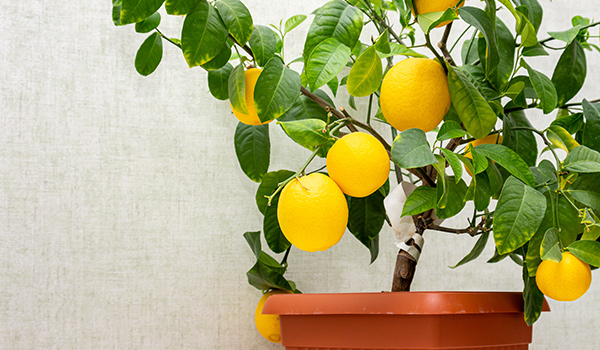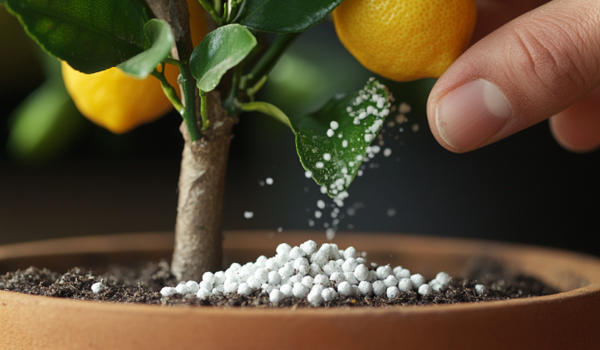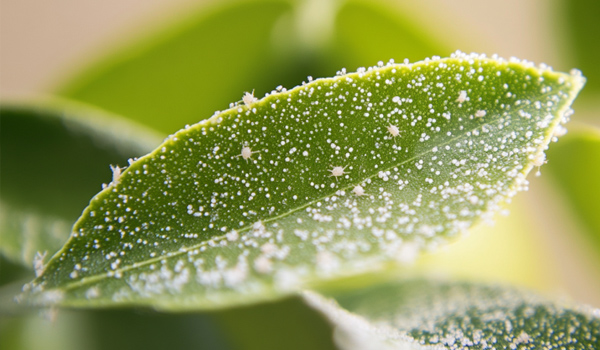Want to grow a lemon tree indoors? It’s easier than you think. This thetreecareguide.com article will show you everything you need to know, from the best lighting and soil mix to watering, pruning, and dealing with pests. Discover how to keep your indoor lemon tree healthy and productive year-round.

Key Takeaways
- Indoor lemon trees need 6-8 hours of sunlight daily; consider using LED grow lights if natural light is insufficient.
- Proper soil drainage is key; use a mix of sand, peat, and perlite to prevent overwatering and root rot.
- Regularly monitor humidity levels and manually pollinate flowers indoors for healthy growth and fruit production.
Optimal Light for Indoor Lemon Trees
Proper lighting is essential when growing lemon trees indoors. These citrus trees thrive on bright light and require 6-8 hours of direct sunlight daily for optimal growth. The best spot for your indoor lemon tree is near an unobstructed south or southwest-facing window, where it can soak up the sunshine.

However, not all homes can provide such ideal conditions. If your indoor space lacks sufficient natural sunlight, LED grow lights can be a great alternative, providing adequate light throughout the day. These lights mimic the spectrum of natural sunlight, helping your citrus plants flourish even in dim indoor environments.
Adequate light promotes healthy growth and vibrant fruit production. Light is as crucial as water and nutrients for growing lemon trees indoors.
Choosing the Right Soil Mix
The soil mix you choose plays a pivotal role in the health and productivity of your indoor lemon tree. Citrus trees require a well-draining potting mix to prevent water accumulation around their roots, which can lead to root rot. An ideal mix typically consists of equal parts sand, peat, and perlite or bark, providing the perfect balance of drainage and moisture retention.
A pot with sufficient drainage holes prevents excess water from lingering in the soil. This setup ensures that while the soil remains moist, it never becomes waterlogged, thereby maintaining optimal soil moisture levels for your lemon tree.
Planting in the right soil mix sets the foundation for a thriving indoor lemon tree.
Watering Your Indoor Lemon Tree
Correct watering is crucial for your indoor lemon tree’s health and fruit production. Daily watering may be necessary in summer due to increased temperatures and growth rates. Adjust your watering schedule according to the seasons to maintain optimal soil moisture levels.
Be cautious of overwatering, as indicated by yellowing leaves, which can signal root problems. Ensure the top 3 inches of soil have dried out before watering to prevent overwatering. Using moisture meters or the finger test can help determine the right time to water.
Water thoroughly, allowing water to drain from the bottom of the pot to keep the roots healthy. This technique encourages deep root growth and prevents water from stagnating around the roots.
Maintaining Humidity Levels
Indoor lemon trees thrive in humidity levels above 50%. Typical indoor environments can be quite dry, especially during winter, so maintaining proper humidity levels is vital for your lemon tree’s health. A humidifier or a moisture tray filled with pebbles near your tree can help maintain the necessary humidity. Regular misting of the leaves a few times a week can also keep your tree happy and healthy.
When your lemon tree is indoors full-time in winter, it is crucial to ensure it gets enough humidity to prevent blossom loss and maintain overall health. Keeping the air around your lemon tree moist helps counteract the effects of dry indoor air and supports healthy growth.
Fertilizing Indoor Lemon Trees

Proper fertilization ensures your indoor lemon tree gets the nutrients needed for vigorous growth and fruit production. Citrus trees require a nutrient-rich diet, relying on nitrogen, phosphorus, potassium, and essential micronutrients like zinc and iron. A general-purpose fertilizer or one specially formulated for citrus trees is recommended.
A proper fertilization schedule includes three applications: during early bud break, during fruit swell, and in late summer. However, avoid fertilizing your lemon tree during the winter months to prevent nutrient overload and ensure healthy growth.
This schedule provides your tree with the necessary nutrients to produce vibrant, juicy lemons.
Pruning and Shaping
Pruning maintains the health and shape of your indoor lemon tree. Proper pruning encourages healthy growth and keeps the tree manageable for indoor environments. Prune in late winter or early spring to avoid removing potential fruit.
Focus on minimal pruning, mainly removing thorns and any unwanted shoots. Prune any dead or diseased wood to improve the overall health of your tree. Wearing protective clothing can help prevent scratches from thorns, which are common in some lemon tree varieties.
Regular pruning ensures your tree remains healthy and productive.
Selecting the Best Indoor Lemon Tree Varieties

Choosing the right variety of lemon trees for indoor growing is crucial. Meyer lemon trees and dwarf varieties like Dwarf Eureka are well-suited for indoor environments. These varieties are known for their compact size and ability to produce fruit in limited space.
Other good choices include the Dwarf Ponderosa and Variegated Eureka Pink lemon, which add a unique aesthetic to your indoor garden. Dwarf lemon trees, Calamondin, and Thai Lime are also excellent options for indoor cultivation. Varieties that produce smaller fruits help conserve the plant’s energy for overall health and fruit production.
Pollination Techniques Indoors
Pollination is necessary for your indoor lemon tree to produce fruit. Since natural pollinators like bees are absent indoors, manual pollination is required. Use a small brush or cotton swab to brush the center of each flower and transfer pollen gently. This process can be done once but may be repeated if needed.

Lightly shaking the branches during blooming can also help with pollination. Fresh air can aid in the pollination process and the overall health of your lemon tree.
These simple techniques will help your indoor lemon tree care bear fruit and produce a bountiful harvest.
Repotting Your Lemon Tree
Repotting your indoor lemon tree is an important part of its care routine. Repot from early spring to mid-summer during the active growth phase. Starting with a small pot helps prevent waterlogging and root rot.
When repotting, choose a pot with a similar depth but a wider diameter to accommodate growth. Gently loosen the root ball before placing it in the new pot to encourage healthy root growth. Proper planting technique ensures the health and productivity of your lemon tree.
Common Pests and Issues
Indoor lemon trees are susceptible to common pests such as:
- spider mites
- scale
- aphids
- mealybugs
These pests can severely affect their health. Low humidity can lead to pest infestations. Regular inspection and prompt treatment are key to managing these issues.

Symptoms of pest infestations include leaf drop and yellowing leaves. Horticultural oil or insecticidal soap can effectively manage pest problems. If pests are found, isolate the tree and treat it with organic insecticide or soapy water.
These steps will help you grow a lemon tree healthy and thriving. Start by listing how to care for your own lemon tree.
Seasonal Care Tips
Seasonal changes significantly influence the care of indoor lemon trees. Move your lemon tree outdoors to take advantage of natural sunlight in warmer months. Gradually acclimate your tree to its new environment to prevent shock. This process is essential for the tree’s successful adaptation.
Before fall temperatures drop, bring your tree back indoors to protect it from cold damage. Be cautious of sunburn when moving your tree outside, as it can damage the bark and attract pests and diseases.
Adjusting your care routine with the seasons ensures your lemon tree remains healthy year-round.
Lemon Tree Summary
Growing a lemon tree indoors can be a rewarding experience, offering both aesthetic beauty and the joy of harvesting homegrown lemons. From ensuring adequate light and the right soil mix to proper watering, humidity, and fertilization, each step is crucial for the health and productivity of your tree.
You can enjoy a thriving indoor lemon tree by selecting suitable varieties, mastering pollination techniques, and staying vigilant against pests. Embrace the seasonal care tips to adapt to changing conditions and keep your tree flourishing. Start your journey today and relish the satisfaction of growing a lemon tree indoors.
Indoor Lemon Tree Frequently Asked Questions
How much light does an indoor lemon tree need?
Your indoor lemon tree will thrive with about 6-8 hours of bright, direct sunlight daily. Make sure to position it where it can soak up that natural light!
What type of soil is best for an indoor lemon tree?
For your indoor lemon tree, a well-draining citrus potting mix with equal parts sand, peat, and perlite or bark is the way to go. This mix will help keep your tree healthy and thriving!
How often should I water my indoor lemon tree?
You should water your indoor lemon tree daily in the summer, but in other seasons, only when the top 3 inches of soil are dry. This will keep your tree healthy and thriving!
How can I maintain humidity for my indoor lemon tree?
To keep your indoor lemon tree happy, try using a humidifier or placing a pebble-filled moisture tray nearby. Regularly misting the leaves can also help boost humidity and keep your tree thriving!
What are common pests for indoor lemon trees, and how can I manage them?
Indoor lemon trees often face pests like spider mites, scales, aphids, and mealybugs. Regularly inspecting your plants and treating them with horticultural oil or insecticidal soap can keep these nuisances at bay.